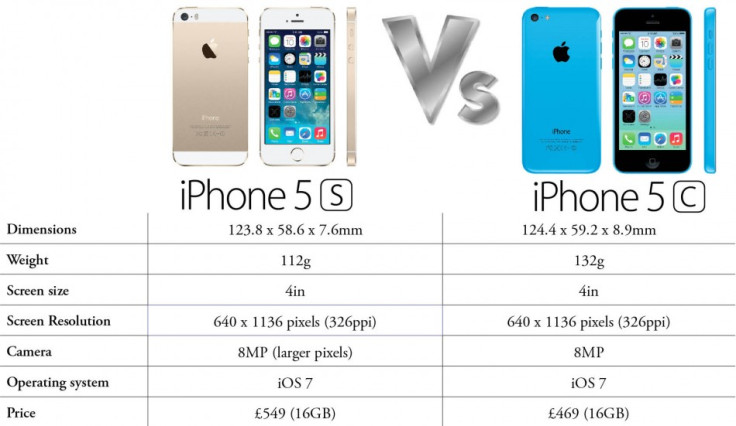iPhone 5S vs iPhone 5C: What's the Difference? [VIDEO]

Apple has announced two new smartphones, the iPhone 5S and iPhone 5C; below we have compared and contrasted them to explain their similarities and differences
Look and Feel
Although Apple announced two new iPhones, the 5S and 5C have a lot in common with each other and with the outgoing iPhone 5. The iPhone 5S has the same size, weight and screen as the iPhone 5, while the 5C also features the same screen, but is marginally taller, wider, deeper and heavier - however, as the above graphic shows there really isn't much to separate them.
The biggest difference is what they are made from. Where the iPhone 5S gets the familiar aluminium back and chassis, the cheaper 5C introduces a new plastic construction. A single piece, the back and sides can be bought in white, pink, yellow, blue and green, and each phone comes with a colour-coded Home screen wallpaper.
By comparison, the iPhone 5S will be offered in three colours: silver, gold and a darker 'space grey'. The gold and silver models have white fronts, while the space grey version is black.
Screen
Both the iPhone 5C and 5S have exactly the same screen, and it's the same as we saw on the year-old iPhone 5. This means a panel measuring four inches corner-to-corner, producing a resolution of 640 x 1136 and a pixel density of 326 pixels per inch. These figures aren't market-leading anymore, beaten by the HTC One and Samsung Galaxy S4, but still make for an excellent screen.
Performance
Apple has given the iPhone 5C the same A6 processor as the iPhone 5 - although the company never reveals specifics, independent tests show this chip to be dual core, running at 1.3GHz and with 1GB of RAM.
The company claims the 5C has a slightly larger battery that last year's iPhone, and that it will manage up to 10 hours of 3G talk time.
Apple used the iPhone 5S announcement to unveil a brand new mobile processor. Called the A7, the system-on-a-chip is 64-bit (a first for any smartphone) and is claimed to be twice as fast as the A6.
This is joined by a new M7 chip, a so-called "motion co-processor" which constantly monitors the device's motion to provide data to fitness tracking applications offered by the likes of Nike.
Despite the extra performance, Apple again claims improved battery life for the 5S over last year's model. This means up to 10 hours of 4G web browsing, or 10 hours of 3G talk time - two more than was claimed for the iPhone 5.
Finally, it's worth noting that both models now work on a much wider range of 4G networks than the iPhone 5 did, meaning they are compatible with the services launched by O2 and Vodafone in August.
Software
Both iPhones run the new iOS 7 operating system, which will be released to owners of older models on 18 September. The only difference between the two phone's versions of the software is the 5S's inclusion of Touch ID. Using a fingerprint reader located on the Home button, Touch ID can be used to unlock the phone instead of entering a PIN or password. The system can also be implemented as a faster way of entering your password when buying content from the iTunes Store.
Otherwise, iOS 7 looks exactly the same on both the 5S and 5C, with its all-new design doing away with the skeuomorphism (real world metaphors such as torn yellow paper in the Notes app), instead opting for a cleaner and simpler design.
Camera
The iPhone 5C gets the same 8-megapixel camera as the iPhone 5, complete with five-element lens, LED flash, autofocus and a hybrid infrared filter. The camera has an aperture of f/2.4 and uses iOS 7's new camera app to take panoramas and Instagram-ready square photos, as well as 1080p HD video.
For the flagship iPhone 5S, Apple has made several important improvements to the camera. It has a larger aperture of f/2.2, an image sensor 15% larger than that used by the 5C, and although the 8-megapixel resolution remains, its pixels are bigger, meaning they can capture more light. All of these improvements mean better quality photos, especially in low light.
The iPhone 5S also gets a better flash than the iPhone 5C. Now a dual-LED unit, the flash can adjust its colour and intensity to produce more natural-looking photos - a system Apple calls True Tone.
Finally, the iPhone 5S can do 1080p HD video, but it can also shoot 720p footage at 120 frames per second; this can then be slowed down to create smooth slow-motion video.
Conclusion
At £469 SIM-free, the 5C didn't turn out to be the budget iPhone everyone was hoping for. Instead, Apple has taken the iPhone 5, added a colour plastic case and reduced the price by £60.
The iPhone 5S is priced from £549 making it £20 more expensive than the outgoing iPhone 5, but with the addition of a fingerprint reader, 64-bit processor and improved camera, the update is on par with what we have come to expect from an 'S' iteration, saving the possibility of a redesign and larger screen for the iPhone 6 next year.
It remains to be seen how much the two phones will cost on contract, and crucially whether the iPhone 5C will be available for free on any reasonable tariffs.
© Copyright IBTimes 2025. All rights reserved.






















